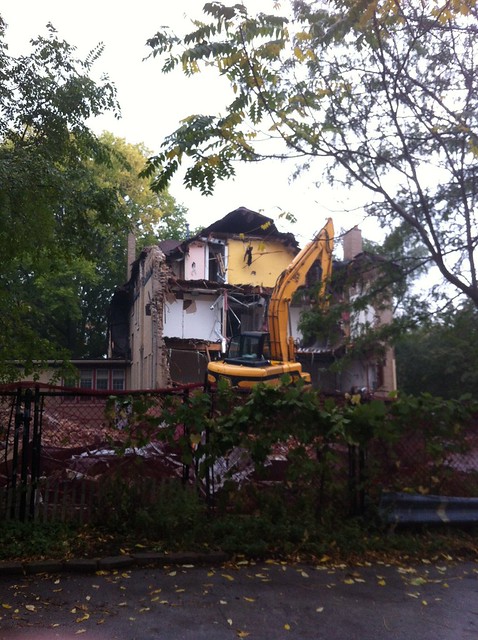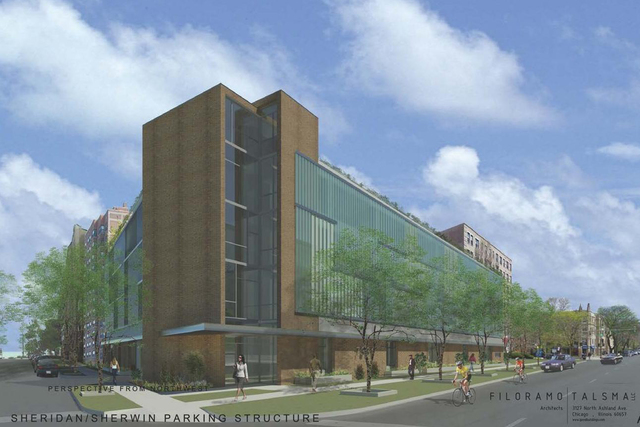Colonel Jennifer Pritzker's crews have demolished the attractive, 90-year-old house, formerly home to the Shambala meditation center, that stood on the Rogers Park lot where the billionaire plans to build a 250-car parking garage. The new structure would largely serve visitors to the Frank Lloyd Wright-designed Emil Bach House and residents at Farcroft by the Lake, an upscale apartment tower, both owned by Pritzker. Eighty-four spaces would be set aside for short- and long-term paid parking for the general public. However, the garage still requires the approval of the Chicago Plan Commission, which is on their October 17 meeting agenda.
There are two major problems with the garage, which opponents have dubbed the Lakefront Car Tower. The first, which we've discussed previously on Streetsblog, is the automobile traffic it will create. The developer's traffic impact study says very little new traffic will be generated. However, the study doesn't take into account how the estimated 2 percent increase in traffic, along with the garage's entrance and exit driveways, will degrade conditions for walking and biking.
It's also likely the 2 percent figure is overly optimistic. Every neighborhood "gets precisely as much traffic as space would allow," according to architect Jan Gehl, known for helping New York City reclaim asphalt for public space, walking and biking.
The second problem is that this parking garage will be paid for twice. The first cost is the $150 per month community members will pay to park here (hourly rates will also be available). The second cost is the decrease in quality of life for Rogers Park residents. While the proposed design is about as attractive as any structure can be whose sole purpose is to warehouse cars, an entire block filled with a four-story structure with no ground-level retail is a boring vista for pedestrians. The garage will prevent the block being used to create more interesting places for residents to look at and and patronize, which would also generate more tax revenue.
Other downsides for pedestrians include the beeping noise when a car is exiting the garage, the signs that tell them to watch out for cars, and cars blocking the walking path. The developer's traffic study predicts that 103 cars will enter and exit between 5 and 6 p.m., the same time people are walking home from the Red Line or bus, and taking their dogs out for a walk.
Lastly, while the garage's vast rooftop will include some landscaping, it will mostly be occupied by parking spaces, which means a net increase in the block's non-permeable surfaces. That will lead to more storm water being dumped into the city's sewer system, contributing to backups, and releases into Lake Michigan. That's yet another aspect of the garage that fails the requirements of the Lakefront Protection Ordinance, whose intent is to "maintain and improve the purity and quality of the waters of Lake Michigan."
Some neighbors have called the extra parking spaces a benefit to Rogers Park, but it comes at too high a cost. If parking is so valuable, why haven't we set up a reasonable system to capture that value? Chicago has tens of thousands of curbside parking spots that are free to motorists and costly to the public, due to to pollution and maintenance costs. But because of the parking meter contract, the city can't earn revenues from metered spaces. It will get some tax revenues from the garage spaces, but not nearly as much money as the garage's owner will make. Residential parking permit fees – $25 annually where they're in place, but are not applied to either block near the structure – could be increased. Additional revenues could be captured and used for a local parking benefit district to fund parkway and sidewalk maintenance, transit, and other initiatives to improve the mobility options for the neighborhood.
It's a problem that new developments are empirically judged on their impact on car traffic and not their possible impacts on neighborhood livability. Rogers Park residents are essentially getting the equivalent of a self-storage locker facility, but one that will bring more auto traffic. The neighborhood deserves better.







